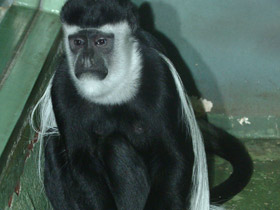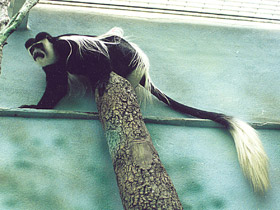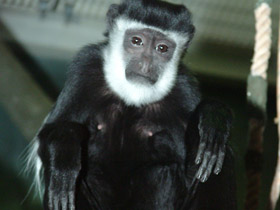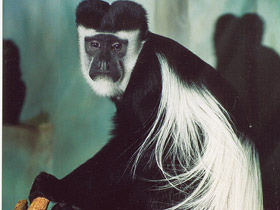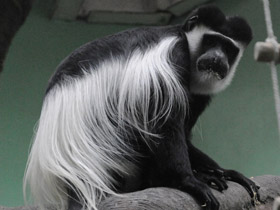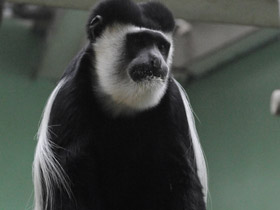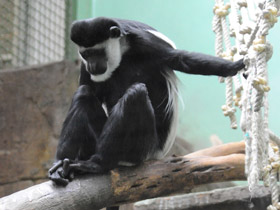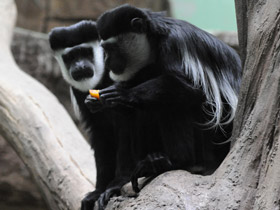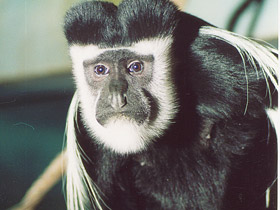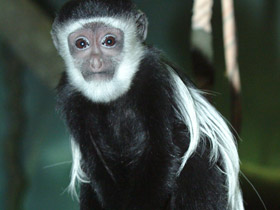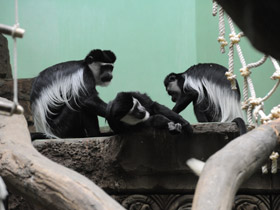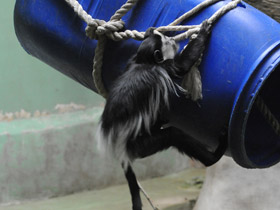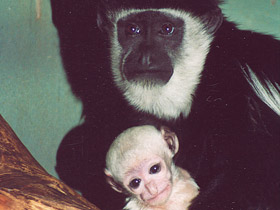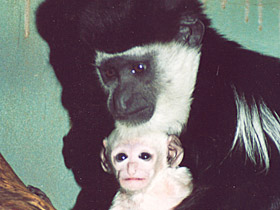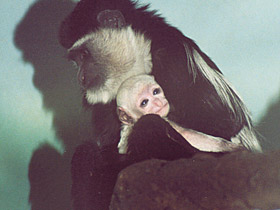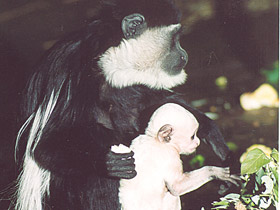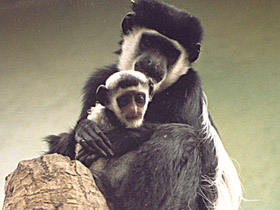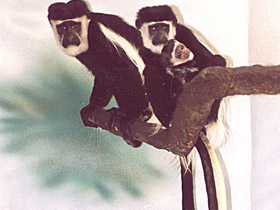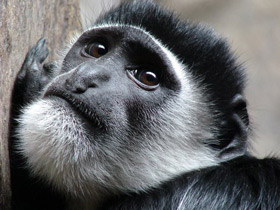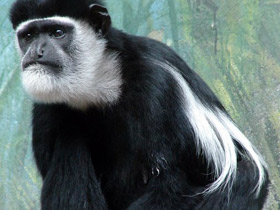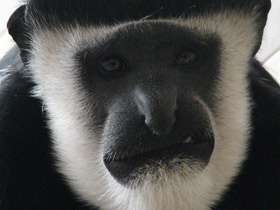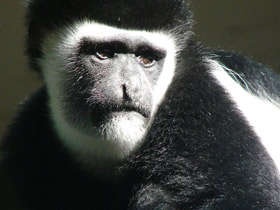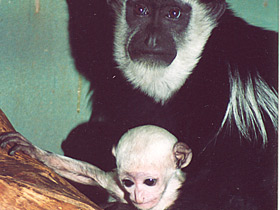The mantled guereza (Colobus guereza), the guereza, the eastern black-and-white colobus, or the Abyssinian black-and-white colobus
The mantled guereza (Colobus guereza), also known simply as the guereza, the eastern black-and-white colobus, or the Abyssinian black-and-white colobus, is a black-and-white colobus, a type of Old World monkey. It is native to much of west central and east Africa, including Cameroon, Equatorial Guinea, Nigeria, Ethiopia, Kenya, Tanzania, Uganda and Chad. The species consists of several subspecies that differ in appearance. It has a distinctive appearance, which is alluded to in its name; the long white fringes of hair that run along each side of its black trunk are known as a mantle. Its face is framed with white hair and it has a large white tail tuft.
Habitat area
Colobus guereza is a species of catarrhine primate of the family Cercopithecidae.
Colobus guereza is widely distributed in equatorial Africa, and is found in northern Congo, eastern Gabon, Cameroon, eastern Nigeria, Central African Republic, northeastern Democratic Republic of Congo, northwestern Rwanda, Uganda, southern Sudan, Ethiopia, western Kenya and adjacent areas of Tanzania. These monkeys inhabit secondary forests along riverbanks, but are also found in dry and humid forests up to altitudes of 3,300 metres above sea level.
Appearance
The body length of the colobus guereza varies from 45 to 70 cm, tail length from 52 to 90 cm, weight varies from 5.5 to 14 kg. The coat of this beautiful primate is glossy black, with white fur around the face and sciatic callosities. On the sides and back, the long white hairs form a U-shaped mantle. The outer side of the thighs is whitish; the fluffy tail is of various colours, white and yellowish from the base to the tip. Newborns are white; at one month they begin to darken and at four months they are adults.
Taxonomic classification
The mantled guereza was first classified by Eduard Rüppell, a German naturalist and explorer, during his trip to Abyssinia between 1830 and 1834. He wrote about the species in Neue Wirbelthiere con Abyssinien, Saengthiere in 1835. It was first seen in Europe in 1890 in Berlin Zoological Garden when three individuals were purchased from a dealer from Massawa, Eritrea.
The mantled guereza is in the Colobinae subfamily, also known as the leaf-eating monkeys, a group of Old World monkeys from Asia and Africa. This subfamily is split into three groups, the colobus monkeys of Africa, of which the mantled guereza is a part, the langurs, or leaf monkeys, of Asia, and an "odd-nosed" group. The African colobus monkeys are divided again by distinctions in color, behavior, and ecology. The three genera are the black-and-white colobi, the red colobi, and the olive colobi. There are three black-and-white colobi: the mantled guereza, Colobus guereza, the king colobus, Colobus polykomos, and the Angola colobus, Colobus angolensis. Groves lists seven subspecies of mantled guereza in Mammal Species of the World (MSW) (2005). The validity of the Djaffa Mountain guereza, Colobus guereza gallarum, is uncertain, although not listed by Groves in MSW, it is recognised in his 2007
Colobinae review paper, and by International Union for Conservation of Nature (IUCN) assessors Gippolliti and Butynski in 2008.
- Western guereza, Colobus guereza occidentalis, occurs from eastern Nigeria, Cameroon, and Gabon at the edge of its western range to South Sudan and Uganda, west of the Nile.
- Omo River guereza or Abyssinian black-and-white colobus, Colobus guereza guereza, found in Ethiopia, in the highlands west of the Rift Valley down to the reaches of the Awash River, the Omo River, and in the Blue Nile gorge.
- Djaffa Mountains guereza or Neumann's black-and-white colobus, Colobus guereza gallarum, found in the Ethiopian Highlands east of the Rift Valley.
- Dodinga Hills guereza, Colobus guereza dodingae, found in the Didinga Hills in South Sudan.
- Mau Forest guereza, Colobus guereza matschiei, occurs from western Kenya and Uganda south into northern Tanzania.
- Mt Uaraguess guereza or Percival's black-and-white colobus, Colobus guereza percivali, found in the Matthews Range in Kenya.
- Eastern black-and-white colobus, Colobus guereza kikuyuensis, occurs in Kenya on the Ngong Escarpment of Mount Kenya and in the Aberdare Range.
- Kilimanjaro guereza, Colobus guereza caudatus, found in Tanzania and Kenya in the forests surrounding Mount Kilimanjaro and Mount Meru.
The morphological difference between subspecies is most pronounced between the southeastern Kilimanjaro guereza, Colobus guereza caudatus, and the northwestern western guereza, Colobus guereza occidentalis. The intermediate subspecies show a gradual change between the two.
Ecology
The mantled guereza is primarily arboreal, but does sometimes descend on the ground to forage and travel, perhaps more so than most other colobines. It is diurnal and rests for up to half the day. Foraging or travelling are the next most common activity. Sometime after dawn, mantled guereza groups leave their sleeping trees and will return to them at dusk. During the day, the mantled guereza has long rest periods in between periods of moving and feeding. Other activities, including grooming, greeting, playing and being vigilant, are performed to a lesser extent.
Despite its reputation as an exclusive leaf-eater, the mantled guereza is not an obligate folivore. While it mainly eats leaves and fruit, its diet is quite variable. It may eat bark, wood, seeds, flowers, petioles, lianas, aquatic-plants, arthropods, soil, and even concrete from buildings. The amount of each food item in its diet varies by area and time of year. Nutritional factors like protein, tannins, and sodium levels in leaves influence its food choices. It may even intermittently travel longer distances to access plants with higher levels of nutrition. Leaves usually make up over half of its diet, although fruits are occasionally eaten more depending on the season. When foraging for leaves, the mantled guereza prefers young ones over old. With fleshy fruits, the mantled guereza prefers to eat them unripe, which may serve to reduce competition with primates that eat ripe fruits. It consumes a number of plant species but only some make up most of its diet at a specific site.
Like all colobi, the mantled guereza is able to digest leaves and other plant fibers with a large, multi-chambered stomach that contains bacteria in certain areas. Like most colobines, it prefers foods with high fiber content that can be easily extracted with its specialized stomach. The mantled guereza is mostly preyed on by the crowned hawk-eagle, but it is also eaten by other birds of prey such as Verreaux's eagle. The common chimpanzee is known to hunt the guereza. The leopard is another possible predator.
Social structure
The mantled guereza lives in stable social groups usually containing three to fifteen members. The groups usually contain one male, several females and juveniles. In some populations, groups containing several males are common. In multi-male groups, males tend to be aggressive with one another with one being dominant. Some males may be expelled from these groups. Multi-male groups may contain father-son pairs or unrelated males. Males that are not part of groups either live solitarily or with other outside males in bachelor groups. The females keep the groups cohesive and they are matrilineally related. They rarely disperse from their natal groups, except possibly when they break apart. Males on the other hand, usually leave when they become subadults or adults. They may start out being solitary and or in bachelor groups. They gain entry into a social group either by being on the periphery or displacing a group male.
Because of its low quality diet and the dispersed distribution of its food, the mantled guereza has a resident-egalitarian social structure. Female guerezas living in a group often have an egalitarian dominance style with no formalized rank relations. Relationships are relaxed and friendly with rare signals of dominance or subordinance. Physical aggression within the group is usually not harmful and rarely escalates into a conflict. Allogrooming is an important part of mantled guereza interactions and mostly occurs between females. The adult males rarely groom in the groups. While not strictly territorial, mantled guereza groups can be aggressive towards each other. In some populations, groups may defend core areas (which exist as a small part of the home range), resources, and mates. During intergroup encounters, males can engage in direct or indirect mate defense, like defending a female's resources. It is the males that participate in agonistic inter-group encounters but female may do so as well. Aggressive encounters between groups usually involve chases, displays and vocalizations rather than physical contact.
Reproduction and parenting
The mantled guereza has a polygynous harem-based mating system. Mating solicitations are made by both males and females, half of the time for each. To solicit mating, the mantled guereza will walk near its potential partner and make low-intensity mouth clicks or tough-smacks. During copulation, the males hold on the female's ankles and body. Most matings take place between individuals of the same group but copulations outside of the group have been recorded. In multi-male groups, more than one male may mate with the females. The gestation period lasts 158 days with a 16–22 month interbirth interval. The newborn guereza relies on its mother for support and must cling to her. As they grow older, infants can move on their own but keep returning to their mothers. The infants take up most of the attention in the groups. The other females in a group may handle an infant although the latter are only comfortable with their mothers. The males normally don't pay much attention to infants until they are four to five weeks old. Infants can eat solid food at about eight to nine weeks and by fifty weeks they are fully weaned and no longer need to hold on to their mothers.

















